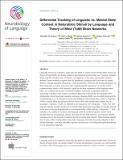| dc.contributor.author | Paunov, Alexander M | |
| dc.contributor.author | Blank, Idan A | |
| dc.contributor.author | Jouravlev, Olessia | |
| dc.contributor.author | Mineroff, Zachary | |
| dc.contributor.author | Gallée, Jeanne | |
| dc.contributor.author | Fedorenko, Evelina | |
| dc.date.accessioned | 2023-03-27T13:15:35Z | |
| dc.date.available | 2023-03-27T13:15:35Z | |
| dc.date.issued | 2022 | |
| dc.identifier.uri | https://hdl.handle.net/1721.1/148768 | |
| dc.description.abstract | <jats:title>Abstract</jats:title><jats:p>Language and social cognition, especially the ability to reason about mental states, known as theory of mind (ToM), are deeply related in development and everyday use. However, whether these cognitive faculties rely on distinct, overlapping, or the same mechanisms remains debated. Some evidence suggests that, by adulthood, language and ToM draw on largely distinct—though plausibly interacting—cortical networks. However, the broad topography of these networks is similar, and some have emphasized the importance of social content / communicative intent in the linguistic signal for eliciting responses in the language areas. Here, we combine the power of individual-subject functional localization with the naturalistic-cognition inter-subject correlation approach to illuminate the language–ToM relationship. Using functional magnetic resonance imaging (fMRI), we recorded neural activity as participants (n = 43) listened to stories and dialogues with mental state content (+linguistic, +ToM), viewed silent animations and live action films with mental state content but no language (−linguistic, +ToM), or listened to an expository text (+linguistic, −ToM). The ToM network robustly tracked stimuli rich in mental state information regardless of whether mental states were conveyed linguistically or non-linguistically, while tracking a +linguistic / −ToM stimulus only weakly. In contrast, the language network tracked linguistic stimuli more strongly than (a) non-linguistic stimuli, and than (b) the ToM network, and showed reliable tracking even for the linguistic condition devoid of mental state content. These findings suggest that in spite of their indisputably close links, language and ToM dissociate robustly in their neural substrates—and thus plausibly cognitive mechanisms—including during the processing of rich naturalistic materials.</jats:p> | en_US |
| dc.language.iso | en | |
| dc.publisher | MIT Press - Journals | en_US |
| dc.relation.isversionof | 10.1162/NOL_A_00071 | en_US |
| dc.rights | Creative Commons Attribution 4.0 International license | en_US |
| dc.rights.uri | https://creativecommons.org/licenses/by/4.0/ | en_US |
| dc.source | MIT web domain | en_US |
| dc.title | Differential tracking of linguistic vs. mental state content in naturalistic stimuli by language and Theory of Mind (ToM) brain networks | en_US |
| dc.type | Article | en_US |
| dc.identifier.citation | Paunov, Alexander M, Blank, Idan A, Jouravlev, Olessia, Mineroff, Zachary, Gallée, Jeanne et al. 2022. "Differential tracking of linguistic vs. mental state content in naturalistic stimuli by language and Theory of Mind (ToM) brain networks." Neurobiology of Language, 3 (3). | |
| dc.contributor.department | Massachusetts Institute of Technology. Department of Brain and Cognitive Sciences | en_US |
| dc.relation.journal | Neurobiology of Language | en_US |
| dc.eprint.version | Final published version | en_US |
| dc.type.uri | http://purl.org/eprint/type/JournalArticle | en_US |
| eprint.status | http://purl.org/eprint/status/PeerReviewed | en_US |
| dc.date.updated | 2023-03-27T13:09:48Z | |
| dspace.orderedauthors | Paunov, AM; Blank, IA; Jouravlev, O; Mineroff, Z; Gallée, J; Fedorenko, E | en_US |
| dspace.date.submission | 2023-03-27T13:09:50Z | |
| mit.journal.volume | 3 | en_US |
| mit.journal.issue | 3 | en_US |
| mit.license | PUBLISHER_CC | |
| mit.metadata.status | Authority Work and Publication Information Needed | en_US |
